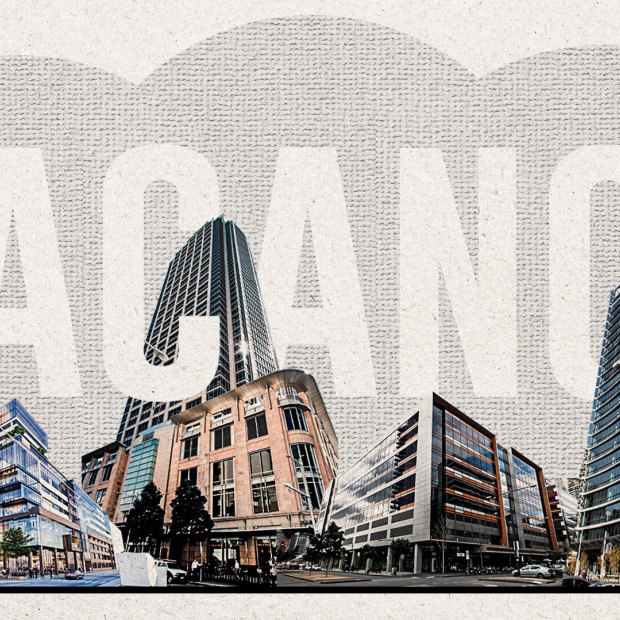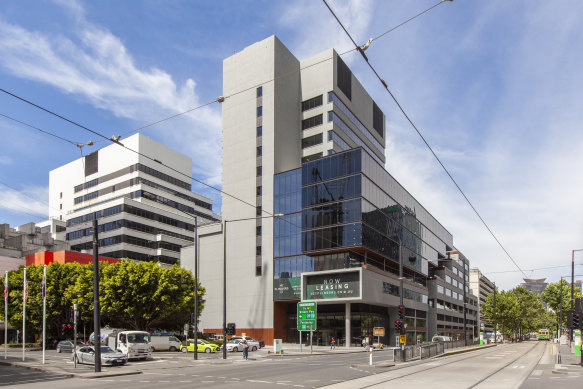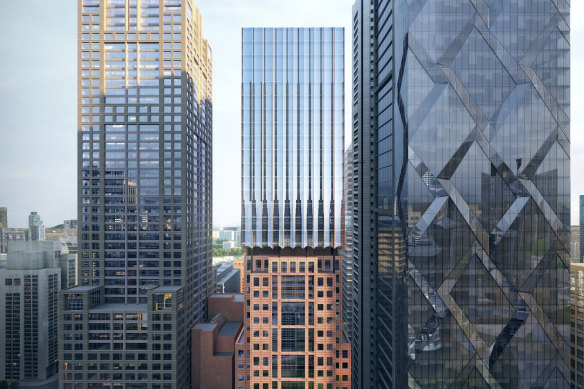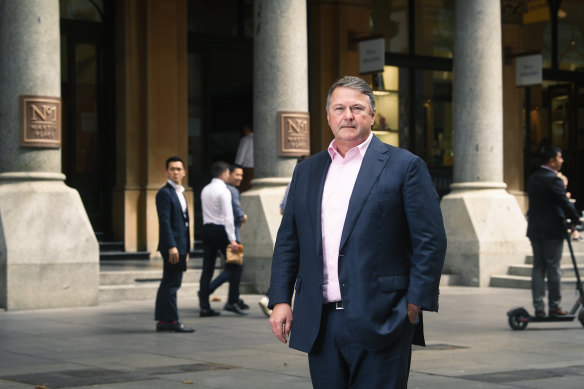This was published 2 years ago
Commercial cannibals: The landlords eating themselves alive

Australia’s biggest landlords are caught in a perfect storm.Credit: Marija Ercegovac
The former home of the Victoria Police at 637 Flinders Street in Melbourne is a modern office tower that has just undergone an $80 million refurbishment. It has high-end facilities and is a short walk from a major train station.
It’s also nearly entirely empty.
Only one tenant as of February – Wesfarmers Health – had taken up space at the 17-storey building that opened late last year. That 10-year lease covers only a handful of floors in the building and is on very generous terms.

The office tower at 637 Flinders Street has recently had a major update and has plenty of space to rent. Credit: Nine
It’s not the only example of the pain the market is experiencing. Across Australia there are office towers that are either empty or have tenants over just a fraction of the lettable area.
The sector has undergone a major structural change as businesses continue to offer flexible work arrangements and many people chose to work from the office only a few days a week and some not at all. The shift to work from anywhere has already had a huge impact on the industry and there are fears that much worse is still to come.
Vacancy rates in Australia’s two biggest cities – Sydney and Melbourne – are at nearly 14 per cent and 15.6 per cent respectively, according to JLL’s March quarter report. On crude maths, that’s the equivalent of one in every seven office towers being empty in both cities. In Perth, the rate is 19.9 per cent and in Brisbane, it’s 13.6 per cent.
The best buildings in top-tier locations such as the Spring Street end of Collins Street in Melbourne, or the towers around Central Station and other CBD train stations in Sydney, are brimming with workers. But some offices that were once considered prime – that is, the very best of the assets – or A-grade assets in Sydney and in Melbourne now feel eerily quiet, with many floors vacant, the foyer cafe closed, and the concierge desks dark and unattended. Few workers walk in and out of these towers even at high traffic times. Several new developments in both cities that are already under way have tenants only pre-committed to about 30 per cent of available space.
An economic slowdown and looming jobs cuts will increase the pressure. In Melbourne, the Andrews government has flagged a head count reduction of as much as 10 per cent and in Sydney financial institutions and tech companies are downsizing their leasing needs.

Mirvac’s proposed addition to the top of 90 Collins Street that has now been shelved as it focuses on other developments. Credit: Artist’s impression
At the same time interest rates increases have put pressure on Australia’s biggest landlords.
It’s a perfect storm that has already resulted in US office landlords handing back the keys to their bankers and the sector awaiting a “tsunami” of refinancing in the US – estimated at $1.5 trillion ($2.24 trillion) – that could put even more pressure on the already strained sector as banks reissue the loans at much higher interest rates. Their values are expected to fall as much as 40 per cent, according to Bloomberg.
Like their US counterparts, office landlords in Australia are facing a similar although less explosive scenario, as fewer tenants equal lower valuations and lower valuations will create higher debt to valuation ratios and nervous lenders.
At the coalface of the sector in Melbourne, Holly Bailey, director of tenancy advisory at Kernel Property, has seen the leasing requirements reduce for major tenants.
“The vacancy rate should continue to climb as new stock is being delivered and tenant contractions flow through,” Bailey says. “St Kilda Road is a bloodbath and landlords in this market, particularly at the southern end, will have more pain to come. It is a similar story for older, typically single occupier Docklands buildings.”

Holly Bailey, director tenancy advisory, Kernel Property, is at the coalface of the office leasing market.
Bailey’s Sydney-based colleague Steve Urwin says a similar trend was occurring in Sydney. “If firms were previously occupying on a flexible desk basis, they are generally reducing footprint – typical are banks, big tech.”
Meanwhile, real rents are falling as property owners effectively buy their tenants by offering incentives – such as fit-outs, rent-free periods or rent reductions – that are equivalent to 40 per cent in Melbourne and 35 per cent in Sydney of the lease value.
Over the past 12 months, the share prices of Australia’s biggest property investors have tumbled, particularly REITs with large office exposures such as Dexus, Charter Hall, GPT and Centuria. (This is despite the groups, which are not alone in experiencing a sector-wide share price downturn, also having significant holdings in other types of commercial property, such as warehouses, which have been performing well.)
The Australian Securities and Investments Commission and fund managers have been upping the pressure on several large property groups to write down the value of their assets, with some market watchers estimating values could fall by 20 per cent this year.
Yet, the swingeing writedowns that have been predicted are yet to materialise, much to the frustration of the investment community.
Stephen Hayes is one of the most respected property investment specialists in the country. He heads up Global Property Securities for First Sentier Investors (formerly Colonial First State) which invests $225 billion on behalf of its clients globally.
Hayes says the commercial property sector has been effectively eating itself alive.

Stephen Hayes is Head of Global Property Securities at First Sentier Investors.
“Most of these landlords, the office focus REITs, are cannibalising their own investments by building these very large buildings that we don’t need,” he said.
“We’re not advocating for the death of the office building or anything like that. We do think it’s got an important role to play providing physical infrastructure for service-based elements of business and government. It’s an important function that it serves.
“However, in terms of an asset that can generate consistent investor returns, that’s a very different story.”
Hayes says current values of most office towers apart from prime, largely full buildings are unsustainable.
“If you look at the major financial centres around the world – London, New York, San Francisco, Boston – asset values for office buildings are off over 20 per cent. So, I can’t see why our financial centres like Sydney and Melbourne should not be experiencing the same level of devaluation.”
“It’s not like these assets didn’t experience a huge amount of value appreciation as vacancy rates firmed right up and net effective rents grew from 2017 to 2020,” Hayes added.
Those values are already undergoing a major market test. Earlier this year, industry super fund REST withdrew from the sale its office tower at 717 Bourke Street after receiving offers of around $390 million – about 15 per cent below its reported book value of $460 million. The Australian this week also reported that Blackstone had withdrawn from sale its $1 billion JPMorgan building in Sydney after being unhappy with the offers it had received.
“Most of these landlords are cannibalising their own investments by building these very large buildings that we don’t need.”
Stephen Hayes, First Sentier
Dexus also recently put up for sale two towers in Sydney – 44 Market Street and 1 Margaret Street. The group quietly reduced the values of the properties by 6 per cent between June and December this year. A spokesperson for the group confirmed the reductions but noted there had been strong interest in the sale. The group parked $1 billion of expected development earlier this year amid the increasingly challenging conditions.
Another major investor who thinks valuations for offices are due for a haircut is industry fund UniSuper – which is a prolific investor in property, holding significant stakes in several large REITs, including a 16 per cent stake in GPT and a $2.8 billion investment mandate with the group and a 12 per cent stake in Westfield mall owner Scentre, as well as unlisted assets including shopping centres and office towers.
UniSuper head of property Kent Robbins says the group has since 2017 made no significant office buy and has been steadily reducing its exposure to the sector, while also increasing its exposure to retail and industrial property.
When looking at office assets, Robbins is focused on two key metrics – capitalisation rates which project the return of the property by dividing a building’s income (i.e. rent) over its book value, and discount rates, a measure to determine the present value of future cash flows from a property.
“We see value declines in the coming quarters as cap rates [calculated by dividing a property’s net operating income by its property asset value] and discount rates ease out on the back of prior interest rate rises and on the back of the expected new market transactions set to occur in the coming months.”
That said, Robbins also believes that many listed group have been sold down too heavily in expectation of much more severe valuation cuts than warranted.

Andrew Parsons from Resolution Capital in London.Credit: Fairfax Media
Andrew Parsons, a global REIT investment specialist and the executive director of Resolution Capital also believes values need to be reduced, but the severity of the cut will be dependent on asset location and quality as tenants seek amenity sustainability and flexibility – a sentiment shared by Hayes and Robbins.
“On the balance of probability given vacancy rates, extra supply, tougher credit markets and based on periods of comparable interest rates it seems reasonable to expect weaker valuations particularly for lower grade or amenity poor properties,” says Parsons.
He adds the other big unknown is the extent of offshore interest in Australia, particularly out of China and Japan, which could prop up values.
“We have some structural or systemic issues – work from anywhere – and already with high vacancy rates we have a slowing economy and job layoffs in technology. So, it’s going to be tough sledding regardless for the next 12 to 18 months.”
Exactly how tough that will be is still anyone’s guess.
David Harrison, an industry veteran and the chief executive of Charter Hall, a sprawling funds management empire that has significant office holdings, believes the sector is better placed than it was during the GFC.
“There are a number of buildings that will come under pressure due to shifting tenant demands, however the suggestion that asset values across the sector will decline up to 20 per cent is off base in my view.”

Charter Hall CEO David Harrison says new and upgraded buildings will be in greater demand.Credit: Peter Braig
“Declines of this magnitude did not occur in the GFC, and we don’t expect it to occur in this cycle either.”
Other landlords are also hopeful. Grant Nichols, Centuria Head of Office and COF Fund Manager also says values in some types of towers that sit outside the prime category still present value to his investors. “You cannot tar all office buildings with the same brush,” he says.
“Further, there is greater investment demand and liquidity for assets worth less than circa $150 million.”
GPT is also seeing greener shoots after its vacancy rate across its office towers hit 12 per cent. A spokesman says: “Since the beginning of the year we have observed increased visitation and vibrancy in the Sydney and Melbourne CBDs, alongside higher levels of utilisation within our office assets and this has coincided with increased levels of tenant leasing enquiry.”
While the office sector is the commercial property sector’s biggest concern right now, but there are also fears about the future for the value and occupancy rates of some retail assets like malls.

Shoppers flocked back to shopping centres in the weeks leading to Christmas.Credit: Joe Armao
The best malls such as Westfield Bondi and Sydney and Chadstone in Melbourne are heavily tenanted while other retail properties, often smaller malls, have a growing number of vacancies that were once filled by small business retailers and family businesses or smaller chains.
Hayes warns that sector is also undergoing a structural change.
“We can’t really generalise because real estate is very much localised in nature. But when we do generalise, it’s probably fair to say that large malls offer a large element of discretionary spend, which is open to online competition and an element of disruption – again, to not accept that is just fraught with danger,” Hayes says.
“So the assets no longer offer an inflationary hedge. They simply don’t. They did for decades, many years ago. But society is rapidly changing and they’re not. So, they need to change.”
Unisuper bucked the trend during lockdown, acquiring interests in Pacific Fair and Macquarie Shopping Centres and the completion of the development of Karrinyup Shopping Centre in Perth.
Robbins says the investment has performed very strongly with significant increases in retailer turnover leading to strong rental outcomes at the centres.
“We continue to monitor sales turnover and the visitation data to detect consumer weakness given the costs of living pressures.”
In this sort of economic environment there have been few shelters from the storm. The most commonly cited defensive style investments are, according to Hayes and Robbins, logistics, storage and convenience retail with supermarket tenanted daily needs style centres performing strongly. Build-to-rent residential communities and land-lease retirement communities are also increasingly popular asset classes for investors.
The key difference between these sorts of investment styles is their ability to collect reliable rents from tenants and the basic necessity of the assets – like the tactile experience of shopping or a place to work from home.
The big question for the office is whether it still satisfies the needs of the population. While many believe it will remain a fixture of both workers’ lives and the investment community, no one knows how much space will be needed.
“COVID-19 lockdowns have changed the daily grind, and we will use technology for some more flexibility,” says Parsons.
“But we are social animals, more will be achieved and learnt through physical interaction and collaboration than in isolation.”
The Business Briefing newsletter delivers major stories, exclusive coverage and expert opinion. Sign up to get it every weekday morning.